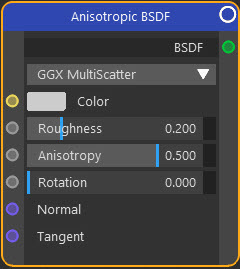Shaders: Anisotropic BSDF
Node Interface

Example output
Overview
| Function | Outputs reflections of other objects and lights |
| Nearest C4D equivalent | Simple material with the reflectance channel enabled and an anisotropic layer added |
This node is identical to the Glossy BSDF shader in that it outputs reflections, but these can be angled in one direction rather than uniformly in all directions.
Settings
Note: a * symbol next to the name indicates the parameter also has an input port. A # symbol indicates that the parameter can only be changed with an input node, not in the node itself.
Distribution drop-down
This menu lets you choose the distribution algorithm for blurry reflections. They do not affect results when the reflection is not blurred (i.e. when Roughness is set to zero). The choice of algorithm is a personal one but GGX produces results which are good for plastics while Beckmann is better for metals.
The default setting is GGX Multiscatter which solves a problem with GGX mode in that as the Roughness value increases, the surface become darker. However, it does produce a slightly noisier result.
Color *
You can change the colour directly in this parameter, but you can input the colour from any other node which has a Color output. This is where you would link an Image Texture node to use a bitmap, for example.
Note that in this node, the Color setting will only alter the colour of the reflection, not the surface.
Roughness*
The 'roughness' of the surface. This is used to alter the sharpness of the reflection. A value of 0.0 will give a mirror-like, pin-sharp result. Increasing the value will blur the reflection.
The range of values is from 0.0 to 1.0.
Anisotropy *
The strength of the anisotropic behaviour. If set to 0.0, the node is identical to the Glossy BSDF shader. The values range from -1.0 to 1.0. Negative values skew the reflection in a different direction to positive ones.
Rotation *
This setting rotates the reflection to change the direction. The range of values is from 0.0 to 1.0, corresponding to a rotation from 0 to 360 degrees.
Normal #
With this setting you can alter the surface normals of the object, which will have a significant effect on the rendered output since it will affect the way light is reflected from the surface.
This setting requires a vector input, so you need to link another node with a vector output port to this port.
Tangent #
Reflections can be skewed along different axes, and this setting is used to choose which axis to use. To do so, you must link a Tangent node to this input; the Tangent node will then let you set the axis to use.
Output
BSDF
A shader port which can be linked with shader ports on other nodes.
